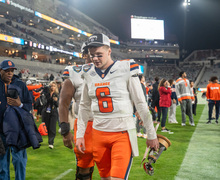New semi-pro soccer team Syracuse FC could roster several Syracuse players
Tony D. Curtis | Staff Photographer
Several Syracuse players could be rostered on this team because they wouldn't be getting paid.
Local soccer players, including those at Syracuse, can play the sport semi-professionally this spring.
Syracuse FC will begin its inaugural season in May after the new National Premier Soccer League expansion team was announced on Feb. 8. Matt Tantalo will take the helm and SU’s all-time leading goal scorer Marcello Vitale will serve as vice president of business operations. The new team will join the area’s entertainment options and reflects soccer’s growth in the United States.
“I think the community is hungry for it,” Vitale said. “Kids are really taking to it. We thought it was the right time, actually it’s a little bit late, to have a professionally run team here in Syracuse.”
The team will compete in the fourth tier of the American soccer pyramid and play home matches at Onondaga Community College, where a 2,000-seat stadium is equipped with lights and turf.
Syracuse FC team members won’t be paid because there’s no mandate to compensate players at the fourth division level. The team can sign active college players, but the staff has not yet spoken with any SU players. Vitale and Tantalo plan to contact Syracuse head coach Ian McIntyre soon to discuss the possibility.
“We want a lot of college kids, so we will stay away from paying players,” Vitale added. “We don’t want to ruin their eligibility.”
The fourth division league started in 2003 and became the National Premier Soccer League in 2005. What began with six teams now has nearly 100. The league has set a foundation for soccer and has fed players into higher leagues, including current MLS player and U.S. Men’s National Team forward Chris Wondolowski. Syracuse FC will have some local opponents, like FC Buffalo and Rochester River Dogz FC.
“It was a pleasant surprise,” Dennis Crowley, owner of Kingston Stockade FC said. “Syracuse is a good size city, and it’s probably a great market for an NPSL team.”
Crowley, an SU alumnus who founded Foursquare in 2009, compares his technology company to his startup soccer club. Entry into the league costs a team $15,000. Lower-level soccer isn’t as profitable as higher leagues, which is why his team doesn’t pay its players.
Crowley said some teams will draw crowds in the thousands, while others will focus on developing players, rather than attracting fans. Syracuse FC wants to be the former. The club has been in contact with the Syracuse chapter of American Outlaws, a United States soccer supporter group, to start a supporter section.
The club isn’t trying to attract tens of thousands of fans like MLS clubs, but instead hopes to attract around 1,600 to 2,000.
Soccer is growing exponentially in the U.S., said Rick Burton, a professor in the David B. Falk College of Sport and Human Dynamics and SU’s faculty representative to the NCAA. U.S. Youth Soccer participation has grown by almost 3 million from 1974 (103,432) to 2014 (3,055,148).
In 2015, SU’s men’s soccer program reached its first-ever Final Four and attendance continues to climb. Syracuse FC wants to capitalize on the momentum but faces unexpected challenges.
“The issue is disposable spending in the marketplace for a team,” Burton said. “You’ve got the Chiefs, you’ve got the Crunch, Syracuse football and the two basketball teams that take a lot of disposable income out of the marketplace. On one hand, soccer is growing. On the other, the market may be saturated.”
Syracuse FC will play at the same time as the Syracuse Chiefs, the Class AAA affiliate of the Washington Nationals. By comparison, Syracuse FC’s season will not overlap with the Syracuse Silver Knights, a member of the Major Arena Soccer League, which averaged 2,082 fans at the Oncenter War Memorial Arena during their 2015-16 campaign.
Fans do not typically come out to minor league games for big name players or rivalries, Burton said, but instead for a fun time, and the club should capitalize on that.
“I think the incentive has to be that they’re going to have a great experience,” Burton said. “It’s going to be easy to park, easy to get a hot dog or a hamburger, and it’s going to be a nice setting where people feel comfortable and can enjoy the weather.”
Published on February 28, 2017 at 11:40 pm
Contact Kenneth: kmintz@syr.edu





